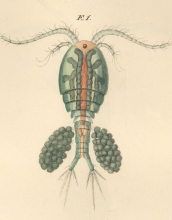News Release 06-051
Freshwater Copepod May Be Several Species, Not Just One
New species can form within a few generations

Copepods like the one in this watercolor have much to tell scientists about evolution.
March 27, 2006
This material is available primarily for archival purposes. Telephone numbers or other contact information may be out of date; please see current contact information at media contacts.
A common and widespread species of freshwater plankton, called a copepod, forms new species at an uncommonly high rate, scientists have discovered. Indeed, a new study has revealed that what was once believed to be a single copepod species is really a collection of many species.
Grace Wyngaard, a biologist at James Madison University in Harrisonburg, Va., and colleagues Andrey Grishanin of the Russian Academy of Sciences, Ellen Rasch of East Tennessee State University and Stanley Dodson of the University of Wisconsin-Madison published their study in the current issue of the journal Evolution.
"The process of forming new species has been cited as one of the most important research topics in biology," said Sam Scheiner, program director in the National Science Foundation (NSF)'s Division of Environmental Biology, which funded the research. "This study provides critical evidence that the ways species form and evolve are more complicated than we had previously understood."
Copepods, microscopic crustaceans that inhabit lakes, ponds, rivers and ditches, serve as the main diet for many fish.
"Some identically appearing forms collected from the same pond cannot mate and produce young, thus defining them as different species," said Wyngaard. "By following the parents and offspring of these plankton in the laboratory, we discovered that they reorganize their DNA dramatically from one generation to the next."
The team collected the copepods from several Wisc. ponds. Because enough variation occurred to significantly alter the animals' genetics in just a few laboratory generations, "The number of copepod species may be much higher than current surveys of freshwater environments lead us to believe," Wyngaard concluded. She and her colleagues suggest DNA in the genomes of some zooplankton may be organized in a way that allows new, and sometimes successful, combinations of genes to arise quickly.
-NSF-
Media Contacts
Cheryl Dybas, NSF, (703) 292-7734, email: cdybas@nsf.gov
The U.S. National Science Foundation propels the nation forward by advancing fundamental research in all fields of science and engineering. NSF supports research and people by providing facilities, instruments and funding to support their ingenuity and sustain the U.S. as a global leader in research and innovation. With a fiscal year 2023 budget of $9.5 billion, NSF funds reach all 50 states through grants to nearly 2,000 colleges, universities and institutions. Each year, NSF receives more than 40,000 competitive proposals and makes about 11,000 new awards. Those awards include support for cooperative research with industry, Arctic and Antarctic research and operations, and U.S. participation in international scientific efforts.
Connect with us online
NSF website: nsf.gov
NSF News: nsf.gov/news
For News Media: nsf.gov/news/newsroom
Statistics: nsf.gov/statistics/
Awards database: nsf.gov/awardsearch/
Follow us on social
Twitter: twitter.com/NSF
Facebook: facebook.com/US.NSF
Instagram: instagram.com/nsfgov


